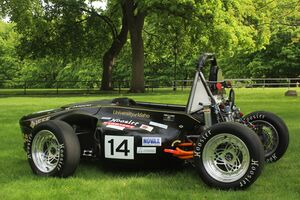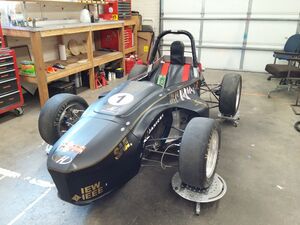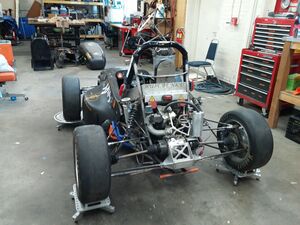Formula Hybrid Car (FHSAE) 2014-2015
| Formula Hybrid Vehicle picture from 2014 | |
| Sponsors | |
| Team Name | Vandal Hybrid Racing |
| Duration | Summer 2014 - Spring 2015 |
| Faculty Advisers | |
| Mentor | |
| Summer/Fall Students |
|
| Fall/Spring Students |
|
The Vandal Hybrid Racing Team is a University organization that competes annually at the Formula Hybrid competition hosted by the Society of Automotive Engineers. This team gives students the opportunity to demonstrate and further develop their engineering skills by challenging them to build a hybrid formula car. Because of the complexity of a hybrid vehicle, building it involves interdisciplinary collaboration between students. For the 2015 competition, the team will be improving upon, testing, and training on the design that won the 2014 competition.
Problem Statement
Because the 2014 frame will be used in the 2015 competition, it is required that significant improvements must be made to the car. The team will strive to improve the car by redesigning problem components, reducing weight where possible, improving car handling, and increasing vehicle efficiency. This will produce a responsive, reliable, lightweight, high performance hybrid car.
Additionally, driver training will be a priority once the car is drivable following upgrades and reassembly. Driver ability can make or break a team at competition, just as much as the quality of the car.
Sub-System Problems and Improvements
Brake Rotors
ISSUES: Front and rear brake rotors are larger than needed; only a fraction of the available friction surface is being used. Also, rear brake rotors are susceptible to cracking due to insufficient heat dissipation of the thin slotted design
GOAL:
- Redesign front and rear rotors, optimizing friction surface areas
- Float both the front and rear rotors to reduce weight
- Rear rotors will no longer be used for wheel speed sensor
PROGRESS:
- Design complete, material needs to be attained or designs need to be ordered.
- Brake rotors have been waterjetted and are on in use on the car.
Rear Wheel Toe
ISSUE: The toe in the rear wheels has slop in it due to flexing and component bending. This causes significant toe movement on the track.
GOAL: Original solution was to shorten tie rods and add a holding bracket attached to the A-frame. Upon further investigation, we need to redesign/repackage the upright assembly so a new solution will be implemented according to the new upright design.
PROGRESS:
- A toe bracket has been manufactured and installed
- New uprights have the toe anchor point moved away from the wheel axis
- New system has been tested and proven
Uprights
ISSUE:
- upright assembly limits workable space for other assemblies
GOAL:
- Redesign upright assembly
- optimize for minimal weight and suspension assembly compatibility
Brake Master Cylinders
ISSUE:
- Brakes lock up after brakes get hot because built up pressure can not be properly alleviated from the high pressure line. Piston doesn't allow fluid to return to reservoir.
- Pedal assembly is heavier than we would like it
GOAL:
- Redesign piston mechanism
- Add a "catch clip" that will return the piston to an open position when no pressure is applied to the brakes
- Repackage pedal assembly to shed weight wherever possible
PROGRESS: New pistons were manufactured and are being used on the car.
Aerodynamics
ISSUE: There are no components to optimize car aerodynamics
GOAL:
- Use CFD knowledge to design a functional underbelly diffuser
- Test model in wind tunnel
PROGRESS:
- 2-D CFD simulations have been conducted. A 3-D model for the diffuser has been made and sent for manufacturing.
- Manufactured diffuser was late and was not able to be put on the car before competition.
Suspension
ISSUE:
- Suspension components could be made lighter
- Suspension system isn't operating as required by competition guidelines
- Suspension system needs to be tuned to improve handling
GOAL:
- Redesign or fix limited suspension travel
- Replace current components with lightweight carbon fiber components
- Tune suspension components on the track
PROGRESS:
- Carbon fiber suspension rods were manufactured
- Titanium uprights were manufactured
- Aluminum ball joint carriers were manufactured
- Manufactured pieces have been installed in the car
Engine Tuning
ISSUES:
- Engine needs to be tuned and maintained at an optimal level
- Last engine lost compression and damaged crank
- Crankshaft had excessive endplay
- Crankshaft showed wear marks behind flywheel, consistent with excessive lateral movement.
- Connecting rod had excessive lateral endplay
The engine was dismantled to inspect components and replace any damaged components. While the engine was off of the car, we noticed the crankshaft had a shaft endplay of 0.0475". The stock engine case allows for 0.016" of endplay. To reduce the amount of endplay in our case, 0.020" shims were placed under the main bearings. This reduced measured endplay to about 0.009" and kept the connecting rod well centered in the cylinder. These shims should stop the crankshaft wearing behind the flywheel and should keep the connecting rod from developing excessive lateral endplay.
GOALS:
- fix crankshaft endplay with under-bearing shims
- Run tests on the dyno engine and use that data to tune the race engine.
- Maintain engine during driving/testing days.
Steering Angle Sensor
ISSUE:
- We currently have no way of logging steering angle data
GOAL:
- Design a sensor that can be used to log real time steering angle on the track
Progress: Design made, needs to be prototyped and tested.
Wheel Speed Sensors
ISSUE:
- Current wheel speed sensor system requires brake rotors for timing. Moving the sensor elsewhere will allow more freedom in rotor design.
GOAL:
- Use a thin slotted wheel mounted somewhere along driveline
PROGRESS: Brake rotors were redesigned slightly to make use of Hall wheel speed sensors easier
Battery Pack
ISSUE:
- Battery box is heavy and could be redesigned to allow the motor controller to fit in front of it
- Battery cell expansion is unknown
- Battery cells overheat and shutdown
GOAL:
- Test battery cells for maximum expected expansion
- Analyze and redesign box according to test results
- Test heat generation from cells
PROGRESS:
- A UHMW plastic box is being constructed that will shed upwards of 25lbs
- An expansion limiting case will allow for 8-12% cell expansion
- 3M thermally conductive padding is being used between cells to dissipate heat and prevent overheating
Regenerative Braking
ISSUE:
- Current coupling to electric motor is a freewheeling bearing
- Freewheeling bearing doesn't allow us to use the electric motor as a brake
GOAL (either):
- Build a remotely-actuated clutch to replace the coupling
- Reduce drag/inertia in motor such that hard-coupling is no longer disadvantageous
PROGRESS:
- Powertrain simulations complete
- Simulation shows that cost/benefit ratio for regen braking is too high
- Project has been discarded
Radiator and Cooling System
ISSUE:
- The internal combustion system is creating too much heat for the current cooling system.
GOAL:
- Create more flow past the radiator for increased heat transfer
- Optimize radiator size for engine temperature desired
- Redesign and fabricate new overflow reservoir
PROGRESS:
- Radiator selected and modified for current cooling system fittings
- Increased mass flow through radiator fins
- Overflow tank fabricated
Ball Joint Carriers
ISSUE:
- The old design could not be implemented onto the current suspension design. In addition, it was made out of steel and weight loss was a priority.
GOAL:
- Create a ball joint carrier that can be applied to the fork insert design for the A-arms
- Reduce weight as much as possible without sacrificing durability and reliability
- Make it out of 7 series grade aluminum
- Allow complete travel for rise and droop without interference
- Safety factor of at least 3
- No press fit to allow more efficient travel and to be easily replaced
PROGRESS:
- Ball joint carriers are on the car and fit both the steel and carbon fiber A-arms
- Reduced unsprung mass
Carbon Fiber Suspension Rods
ISSUE:
- The old steel suspension rods did not look great and were very heavy
- Suspension rods of different lengths were needed to tune the suspension
GOAL:
- Make carbon fiber/aluminum rod samples and strength-test them
- Model the theoretical strength of components using FEA and traditional calculations
- Tune the suspension as desired, then cut the new suspension rods so that their median adjustment is at current suspension tune
PROGRESS:
- Materials were ordered
- Aluminum rod ends were machined
- Rod ends were bonded to carbon fiber tubes
- Completed rods were individually proof tested for estimated load with 3x safety factor
Current Car
Team Biographies
| Team Member | Major | Projects |
| Gordan Jokic | Electrical and Computer Engineering |
Accumulator Testing and Wiring, Motor Characterization, Competition Safety Paperwork |
| Grant Lang | Electrical and Computer Engineering |
Control System Programming |
| Troy Ledford | Electrical and Computer Engineering |
Accumulator Testing and Wiring, Motor Characterization, Battery Box PCB Design, Competition Safety Paperwork |
| Alan McMurray | Mechanical Engineering |
Suspension Design, Fabrication and Tuning, Dynamic Modeling |
| Jon Wheless | Mechanical Engineering |
Powertrain Simulation, Suspension Fabrication |
| Ben Palmer | Mechanical Engineering |
Battery Box Thermal and Mechanical Design, Fabrication |
| Jake Charlton | Mechanical Engineering |
Battery Box Thermal and Mechanical Design, Fabrication |
| Jeffrey Discolo | Mechanical Engineering |
Suspension Design and Fabrication, Specialized Welding |
| Justin Pettingill | Mechanical Engineering |
Cooling System Thermal and Mechanical Design |
| Bryan Tiniacos | Mechanical Engineering |
Team Management, Ball Joint Carrier Manufacture, Being Really Buff |


